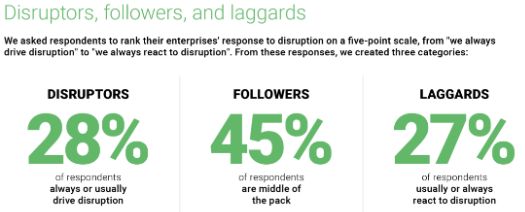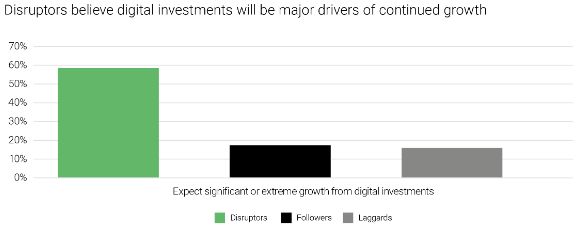- in European Union
- in European Union
- in European Union
- with readers working within the Healthcare, Technology and Retail & Leisure industries
Insights from our 2023 Digital Disruption Survey
Among disruptive forces, digital innovation is a special beast—enormous, ubiquitous, affecting every aspect of an enterprise's operations. Digital disruption is different from forces like demographic or climate change, the retreat from globalization, geopolitical events, or macroeconomic cycles, which are largely out of the control of any one company.
Why? Because companies can create digital disruption, not just react to it.
Earlier this month, we published the AlixPartners 2023 Digital Disruption Survey Report, which examines how companies struggle and succeed in coping with digital disruption.
We surveyed 250 C-suite executives from companies in North America, the United Kingdom, and the European Union, to learn about the degree to which their business is being disrupted by digital technologies, the pace at which these disruptive forces are accelerating, the strategies they are employing to confront them, and the impact of digital disruption on their companies' performance.
We started by asking them whether their companies mostly drove digital disruption or reacted to it. Only about a quarter of respondents reported that they are consistently leading disruption. The rest are letting others set the agenda for them. Some followers may be trying to strike that balance of being able to learn from others' mistakes. But they and especially the laggards may also be missing the first mover advantage.

The full survey reveals the practices of companies that earn the highest ROI on their digital investments, the challenges that executive teams face in developing trust and a strong working relationship between technology executives and other leaders, and how companies are leveraging artificial intelligence.
We boiled it down into five key findings that set the digital investment agenda:
- Growth leaders achieve higher ROI from digital investments, and notably higher profit margins (5.6% vs. 2.9%).
- only 10% of leaders say they can consistently rely on their senior technology leaders to deliver on business outcomes of technology projects, or to leverage technology to drive top-line growth.
- most companies are pouring good money after bad. 87% of those who say they're not achieving consistent ROI from tech spend are nevertheless spending the same or more than they did last year.
- 75% of execs say AIwill be extremely/very important to their industry, but only 21% give their company an A grade for how well they address it.
- those realizing ROI from their tech investments are almost 80% more likely to be prioritizing cybersecurity optimization in current or near-term plans.

Key takeaways
Two words sum up the results of this study: PRACTICAL DIGITAL.
Whether exploiting new digital advances or defending against the disruption they cause, the most successful companies are determinedly pragmatic.
They insist that business goals determine technology priorities
The fastest growing companies are better than their rivals at aligning digital investments to strategy, governing in an action-oriented and cross-functional way, setting and sticking to priorities, and doing research about where and how to invest. In particular, they have the view that digital technologies should be used to enable growth as well as efficiency, and devote a greater portion of their digital spending to activities that create value with and from customers
They are bold
Growth leaders are more likely than others to see disruption as an extreme threat to their business; but they are also more likely to seize it head-on and turn it to their advantage. They prioritize pace over perfection. As a result, those who drive growth in their industries also tend to drive disruption, and vice versa.
They execute
In addition to investing more intelligently and aggressively, leading companies simply out-execute others when it comes to digital. They have a comprehensive plan that is tied to business strategy. That plan has clear, time-defined goals with documented ROI and action-oriented governance. Furthermore, they intend to increase that executional advantage by pouring more of their digital spending into technologies that will help them make sharper, faster, and better decisions.
The pace of change continues to accelerate. Industry leaders are expanding their leads over the rest of the pack, and technology is necessarily at the center of their success. Digital is no longer the purview of the IT department—it is embedded throughout an organization and its business strategy.
Take action today, with a bold but practical approach to digital transformation that ensures the continued success of your business into the future.
The content of this article is intended to provide a general guide to the subject matter. Specialist advice should be sought about your specific circumstances.




